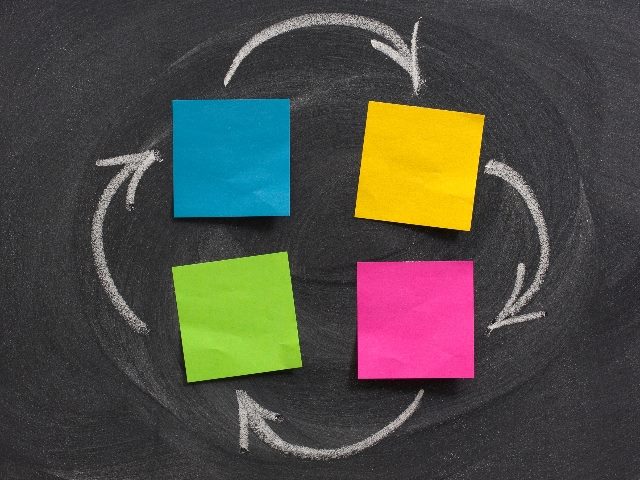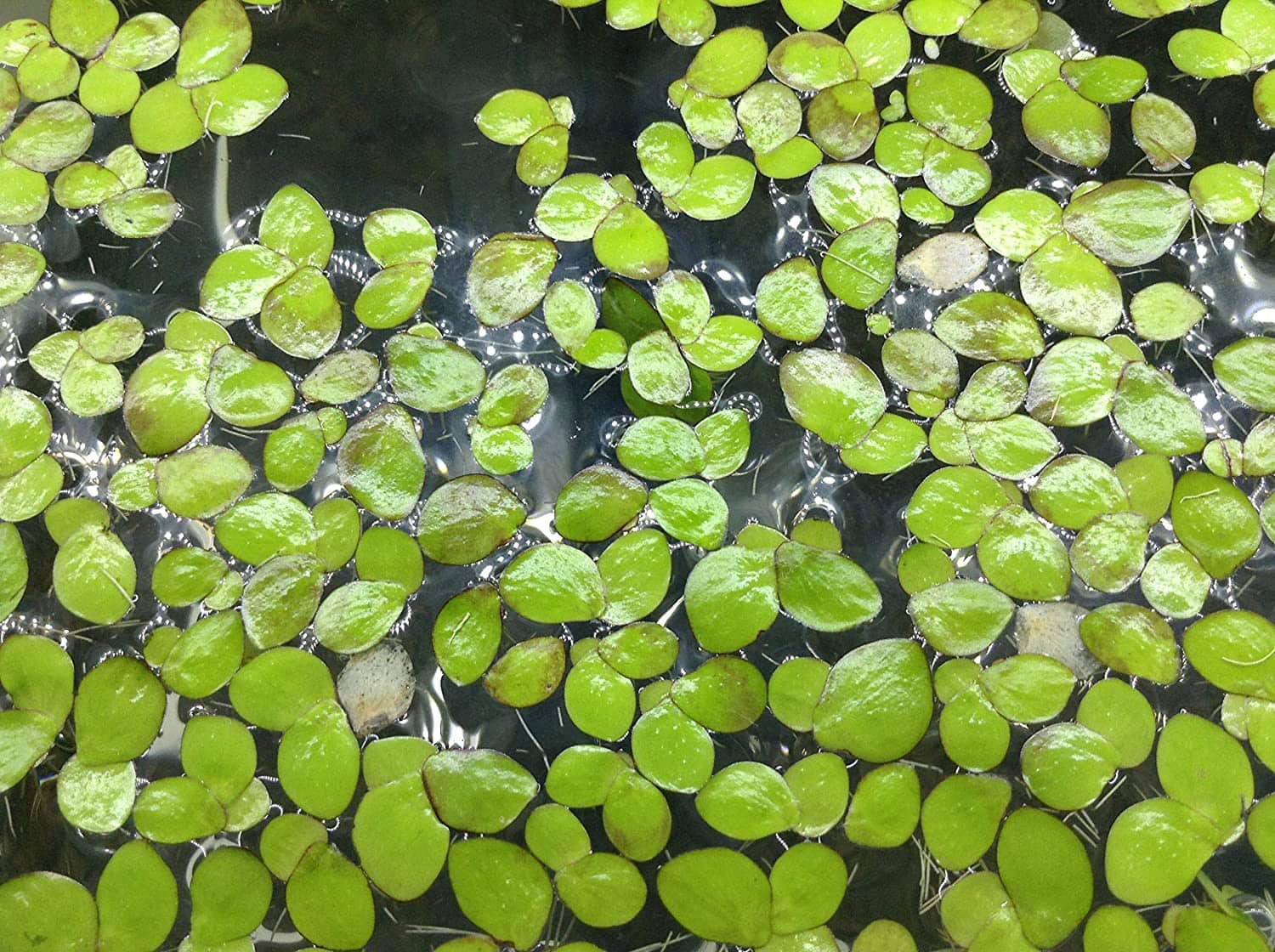
If you’re new to goldfish ownership, you may be hoping to find the perfect plants for your new fish tank. If you’re an experienced goldfish owner, you’re probably hoping to find a single plant that your goldfish can’t destroy within 35 seconds. Regardless of which category you’re in, you’re in luck! There are plants that can make your aquarium look nice and withstand all the abuse your goldfish can throw at them.
These reviews of the top 10 plants for goldfish will help you find the perfect plants for the look you’re hoping for. These reviews will also help you find plants that your goldfish won’t destroy quickly. Keep in mind that all tanks and fish are different, so what works for some or most might not work for your tank. Sometimes, it just comes down to trial and error, but these reviews will provide you a starting point.
A Quick Comparison of Our Favorites
The 10 Best Plants for Goldfish Tanks- Reviews 2021
1. Java Fern

| Growth Rate: | Slow to moderate |
| Max Height: | 14 inches+ |
| Light demands: | Low to high |
| CO2: | Optional |
| Difficulty: | Easy |
Java Fern is easily the best plant for most goldfish tanks because it’s so easy to care for and most goldfish won’t try to eat it. A big benefit of Java Fern is that it doesn’t require substrate. In fact, it doesn’t want to be planted in substrate and will die quickly if all of its rhizomes are buried. Java Fern grows best attached to a hard surface, like driftwood or rocks. This can easily be accomplished with fishing line or cyanoacrylate glue, better known as superglue. Since it grows on surfaces, you can keep Java Fern in bare bottom tanks or tanks with substrate.
The downside of this plant is that is has such a slow growth rate that it is prone to collecting algae, although growth can be sped up with high lighting. There are multiple things you can do to prevent this, including algae eating animals and algae-killing treatments, but it is still a possibility. Otherwise, it’s easy to propagate via rhizome division and it will grow pups on a mature leaf that will eventually drop to the bottom and attach to whatever they land on.
Pros
- Easy to care for
- Minimal light required
- Unappetizing to most fish
- Doesn’t require substrate
- Can be attached to multiple types of surfaces
- Propagates easily
Cons
- Will die if all rhizomes are buried
- Slow growth may lead to algae
2. Hornwort
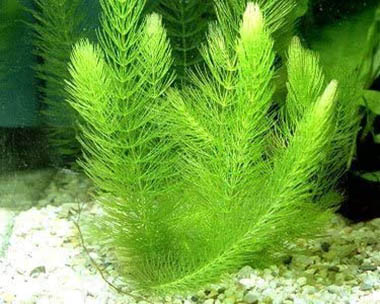
| Growth Rate: | Rapid |
| Max Height: | 10 feet |
| Light demands: | Moderate |
| CO2: | Optional |
| Difficulty: | Easy |
Hornwort is one of the easiest plants you can possibly use in your goldfish tank. It can be grown planted in substrate or floated, so you can grow healthy Hornwort just by tossing it into your tank. It grows rough spines that are generally unappetizing to most fish, so it’s unlikely to get eaten. It has a rapid growth rate and can grow multiple inches per week, so even if your goldfish snack on it, you should have no shortage of Hornwort in your tank. In low light or high light environments, Hornwort tends to shed its spines into the water, which can create quite a mess. This is more common in low light.
In the wild, Hornwort can reach up to 10 feet in height, but it does not grow very much above the waterline, so it’s unlikely to get 10 feet tall in your living room. However, it still gets quite tall and will require routine trims to keep it in line. Hornwort is easy to propagate and can even be cut into smaller pieces with each piece growing into a new plant.
Pros
- Easy to care for
- Rapid growth rate
- Only requires moderate light
- Unappetizing to most fish
- Doesn’t require substrate
- Propagates easily
Cons
- Low or high light causes it to shed
- Needs regular pruning
3. Anubias
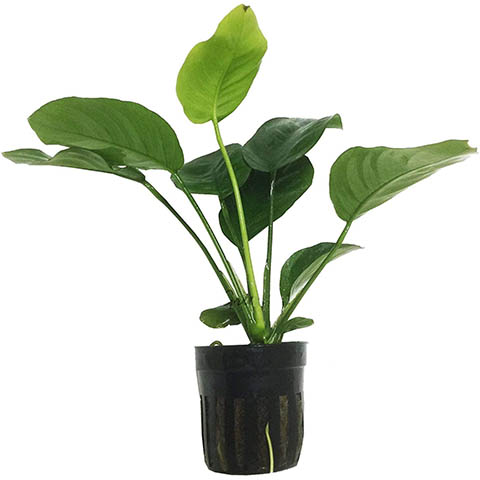
| Growth Rate: | Slow |
| Max Height: | 12 inches+ |
| Light demands: | Low to moderate |
| CO2: | Optional |
| Difficulty: | Easy |
For another easy aquatic plant that doesn’t require substrate, look no further than Anubias plants. These plants prefer to be attached to surfaces and don’t like their rhizomes to be covered. They will put out some roots that will help aerate your substrate, but they don’t require substrate. Anubias is a genus of plants that includes over a dozen species that are found in aquariums. They range from the adorable Anubias barteri nana that is 2-6 inches tall to the enormous Anubias gigantea, which has leaves that can exceed 12 inches in length, and that doesn’t even account for the height of the stems and base.
Like Java Fern, Anubias can suffer from algae collection due to its exceptionally slow growth, so you’ll need to monitor this. High lighting and CO2 will help Anubias plants grow more quickly, but they still are not considered rapid growth plants. Anubias propagate easily via rhizome division.
Pros
- Easy to care for
- Low to moderate light requirement
- Unappetizing to most fish
- Propagates easily
- Doesn’t require substrate
- Multiple varieties
Cons
- Will die if all rhizomes are buried
- Slow growth may lead to algae
4. Vallisneria
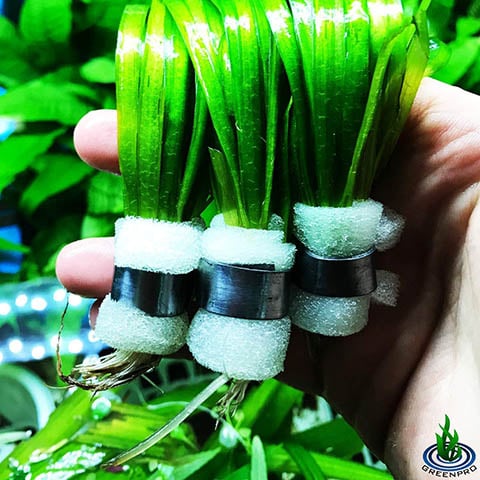
| Growth Rate: | Moderate to rapid |
| Max Height: | 6 feet |
| Light demands: | Low to high |
| CO2: | Optional |
| Difficulty: | Easy |
For a grassy look, Vallisneria plants are a great option. Like Anubias, Vallisneria is a genus that includes over 30 species, 6 of which are widely grown for the aquarium industry. Vallisneria gigantea is the largest variety at almost 6 feet in height, while Jungle Vallisneria, or Vallisneria americana, is a large variety that is also the most popular. These plants can survive in low light environments but will thrive in moderate to high lighting. Low light may cause them to get leggy as they stretch for more light, while moderate to high lighting will help them grow fuller. Most goldfish will not eat Vallisneria, but some consider it a delicacy, while others will quickly uproot it.
CO2 is not required to grow Vallisneria, but it does need routine fertilization to ensure it grows healthy and full. Vallisneria plants propagate via runners that are sent out from a mother plant. Once they have roots of their own, these runners can be detached from the mother plant and planted separately.
Pros
- Easy to care for
- Only requires moderate light
- Propagates easily
- Unappetizing to most fish
- Multiple varieties
Cons
- Will become leggy in low light
- Grows best with fertilization
- Some goldfish enjoy eating or uprooting this plant
5. Java Moss

| Growth Rate: | Slow to moderate |
| Max Height: | 5 inches |
| Light demands: | Low |
| CO2: | Optional |
| Difficulty: | Easy |
For a mossy goldfish tank, Java Moss is likely your best bet. Most goldfish won’t eat Java Moss and it can be grown from very small amounts, so even if your goldfish eat or uproot most of it, it’s likely to grow back eventually, albeit very slowly. The easiest way to grow Java Moss is to attach is to surfaces with superglue, but it can also be tied or weighed down until it takes hold of a surface. Java Moss can be used to create moss walls, carpets, or décor covering.
Java Moss can be a mess on initial setup, and it can be an even bigger mess once your goldfish get ahold of it. If not attached well or uprooted by fish, Java Moss will quickly become a floating mess in your tank and will get sucked into your filter. This plant propagates easily via cuttings and can be grown from a single small piece.
Pros
- Easy to care for
- Low light requirement
- Propagates easily
- Can be used for carpets, walls, or décor coverings
- Doesn’t require substrate
Cons
- Can be messy
- Grows slowly
- Must be weighed or attached to a surface until it takes hold
6. Water Sprite
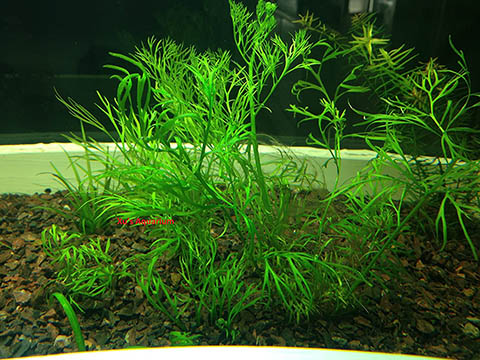
| Growth Rate: | Moderate |
| Max Height: | 14 inches |
| Light demands: | Low to high |
| CO2: | Optional |
| Difficulty: | Easy |
Possibly the peak of easy to grow, Water Sprite, is a great addition to goldfish tanks. This plant can be grown planted in substrate or allowed to float in the tank. It has coral-shaped leaves and grows moderately once established. Most fish won’t eat Water Sprite and they seem to enjoy swimming through its branches and leaves, whether planted or floated. Water Sprite can survive in low light environments but will grow more slowly than it does in moderate or high light environments. Most fish won’t eat Water Sprite.
Water Sprite propagates incredibly easily. So easily, in fact, that a single leaf or branch can sprout roots. The roots can become quite long and may even attach themselves to substrate or décor. You could take a pair of scissors to some Water Sprite and end up with dozens of plants. Once you have Water Sprite, it’s extremely difficult to fully get rid of.
Pros
- Easy to care for
- Can grow in low light environments
- Propagates easily
- Doesn’t require substrate
- Unappetizing to most fish
Cons
- Slow growth rate until established
- Grows best in moderate to high lighting
- Difficult to get rid of
- Can root itself to décor and substrate
7. Amazon Sword
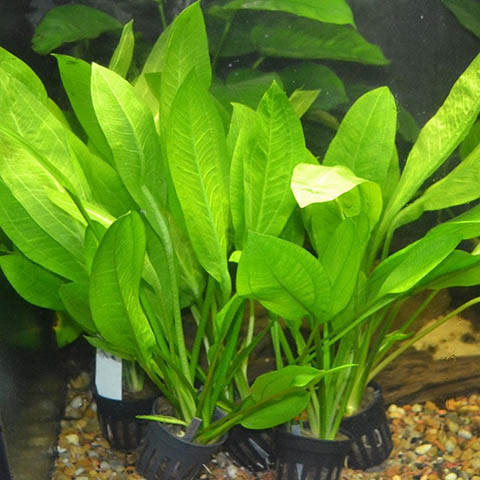
| Growth Rate: | Slow to moderate |
| Max Height: | 16 inches |
| Light demands: | Moderate |
| CO2: | Optional |
| Difficulty: | Easy |
Amazon Swords are a great addition to goldfish tanks because many goldfish will not eat them. This plant does need to be planted into some type of substrate and produces extensive root systems, which help aerate your substrate. Amazon Swords can survive in low lighting but will not grow well.
Amazon Swords do require root tabs because they do not pull nutrients from the water column very efficiently. They also grow best with CO2, but it is not required. Since these are slow to moderate growth plants, algae may become an issue. These plants do get quite tall, so they are not recommended for small goldfish tanks. Amazon Swords propagate via runners from the mother plant.
Pros
- Unappetizing to most fish
- Easy to care for
- Only requires moderate light
- Roots will aerate substrate
- Propagate easily
Cons
- Root tabs are required for healthy growth
- Slow to moderate growth may lead to algae
- Not recommended for small tanks
- Some goldfish enjoy uprooting this plant
8. Aponogeton
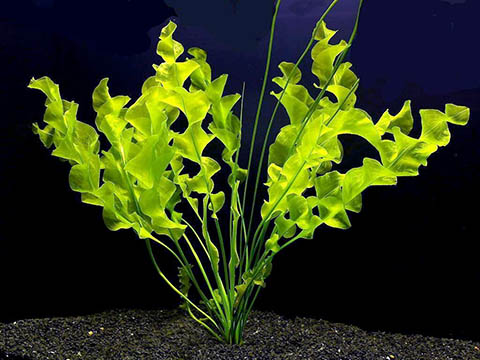
| Growth Rate: | Rapid |
| Max Height: | 18 inches+ |
| Light demands: | Low to high |
| CO2: | Optional |
| Difficulty: | Easy |
If you’ve ever spotted bulbs in the pet store that are geared toward betta tanks, you’ve likely spotted Aponogeton bulbs. Aponogeton is a family of plants that contains around 50 species. These plants are excellent options for goldfish tanks because they grow rapidly. Extremely rapidly. They can easily grow multiple inches per day in moderate to high lighting. Once they are rooted and established, your goldfish will likely leave them alone. The difficult part will be keeping the bulb in the substrate until it becomes established.
It’s important to plant these bulbs so that they are not completely submerged under the substrate. Otherwise, the bulb may rot. Soft substrates, like sand, are recommended for Aponogeton plants so they can grow well. If they have difficulty spreading their roots into the substrate, they will not grow well.
Pros
- Extremely rapid growth rate
- Low light requirement
- Easy to care for
- Unappetizing to most fish
- Multiple varieties
Cons
- Extremely rapid growth rate
- May be difficult to keep the bulb planted until established
- Bulb will rot if planted too deep
- Requires soft substrate
9. Duckweed
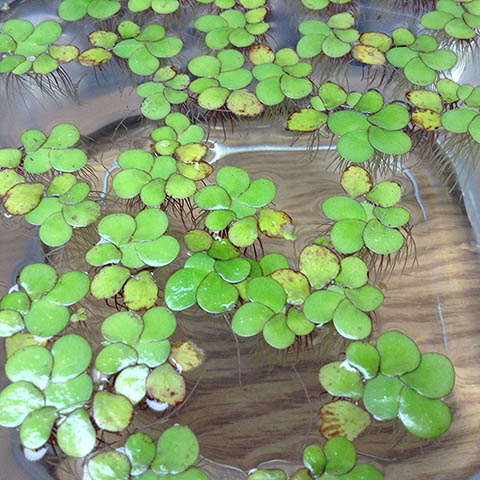
| Growth Rate: | Rapid |
| Max Height: | 5 inches |
| Light demands: | Moderate to high |
| CO2: | Optional |
| Difficulty: | Easy |
If you’ve ever thought that you want a plant that reproduces basically in the blink of an eye, then look no further than Duckweed. Considered a pest species in many areas, Duckweed is a floating plant that’s great for goldfish tanks because they love to eat it, but it grows so rapidly that it’s difficult for the fish to decimate the population. Duckweed can double in size in 16 hours. This also means that once you have Duckweed, you’ll never get rid of it. You might think you’ve cleared it from your tank only to wake up the next morning to a bunch of it from tiny leaves you missed.
Due to its invasive nature, Duckweed may not be legal to own or purchase in all areas, so you may check the laws in your area before attempting to purchase. Propagation will be no issue with Duckweed due to its rapid reproduction rate. If you ever find yourself overwhelmed with Duckweed, there are fish food recipes available that include Duckweed.
Pros
- Extremely rapid growth rate
- Reproduces faster than goldfish can eat it all
- Can be used to make fish food
- Great floating plant option
Cons
- Extremely rapid growth rate
- Difficult to get rid of
- Not legal in all areas
- Must be kept under control to avoid blocking light and nutrients to other plants
10. Peace Lily

| Growth Rate: | Slow to moderate |
| Max Height: | 6 feet |
| Light demands: | Moderate |
| CO2: | Unnecessary |
| Difficulty: | Moderate |
Peace Lilies are not an aquatic plant, but they love water and grow well with their roots submerged. If you plant a Peace Lily in your tank’s substrate, it will die. Peace Lilies are a great plant to plant outside your tank with the roots in the water. These roots will help pull nutrients, like nitrate, from the water, improving your water quality. Your goldfish might chew on these roots, but they’re unlikely to do much damage.
It should be noted that, like all members of the Araceae family, Peace Lilies are highly toxic to cats and dogs. They are also dangerous for humans if consumed, so if you have curious children that put everything in their mouth, avoid Peace Lilies. They are not dangerous for goldfish, though, and make a beautiful statement plant above your tank. Keep in mind that Peace Lilies will need to be in a room where they receive moderate lighting since your aquarium lighting will not cover enough of the plant for it to adequately produce chlorophyll.
Pros
- Only require moderate lighting
- Does not require CO2
- Improve water quality
- Unlikely to be damaged by goldfish
Cons
- Cannot be fully submerged in the tank
- Moderate care difficulty
- Toxic to mammals
- Require moderate room lighting
Buyer’s Guide
What to Look for When Choosing Plants for Your Goldfish Tank
Durability
Hardy plants are going to survive much better in a goldfish tank than tender plants will. Goldfish are notoriously hard on plants, so you want to look for plants that are unappetizing to fish, difficult for fish to eat, or that reproduce quickly enough that goldfish eating them won’t matter. Sometimes, all you need is for a plant to survive the initial goldfish siege and then they’ll lose interest in the plant and leave it alone.
Care Level
This is mostly based on personal preference, but for a goldfish tank, you will want to choose low or moderate care level plants. High care level plants are often more easily damaged and will not last long in a goldfish tank. The care level will also determine the time and effort you will have to put into the plant, so take that into consideration as well.
Size
Some plants can get quite large, so it’s important to know what size you may be looking at. Some plants will stay short but will spread in the tank, while others will keep growing taller until they breach the water’s surface. Tank shape and size should be taken into serious consideration when choosing plants.
Health
Make sure you’re purchasing plants that appear healthy. It’s a good idea to quarantine plants or do a bleach dip before adding them to your tank to kill parasites and bacteria. Nobody selling live plants can absolutely guarantee the plants won’t contain snails, but you do want to make sure you’re purchasing plants that look healthy, have new growth, have no signs of rot or disease, and are coming from a healthy-looking environment.
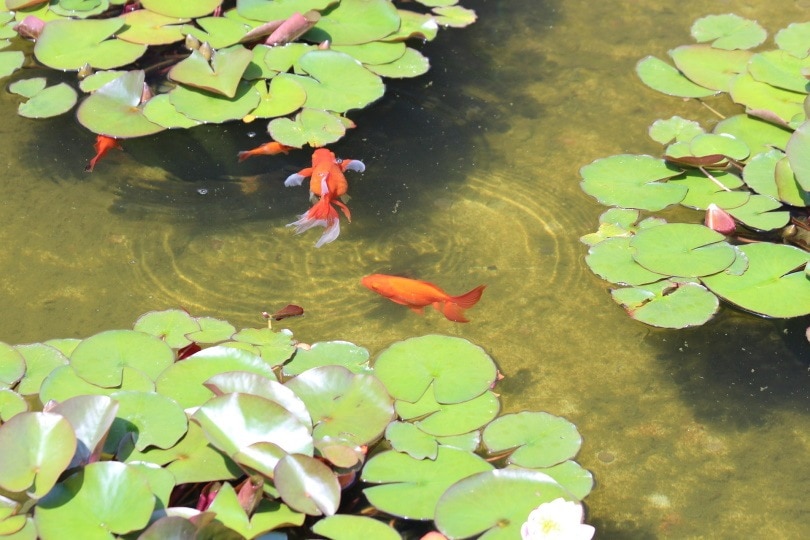
Tips for Choosing Plants for Your Goldfish
- Your Goldfish: Choose plants that you think will meet your goldfish’s preferences. If your goldfish enjoy eating lots of greens and plants, then Duckweed is probably a good option for you. If your goldfish enjoy having plants that are tall that they can swim through, then plants like Vallisneria and some species of Anubias are good picks. Remember that sometimes it’s trial and error when it comes to picking plants for your goldfish!
- Your Tank: If your tank is long and short, then you can have different plant shapes and sizes than you can if your tank is tall and narrow. Something like Java Moss will work well in just about any tank size and shape, but Jungle Vallisneria may be too tall for a short tank. It’s also important to check out the variety or species of plant you are buying. There are many plant families that have multiple species available in the aquatics trade. There’s a big difference in how much space Anubias barteri nana will take up in your tank compared to Anubias gigantea.
- Your Preference: Take your own preferences into account when choosing plants! What’s the look or theme you’re going for in your goldfish tank? Some people prefer lots of small plants while others prefer fewer plants that are large and take up a lot of space. You will have multiple options for just about any idea you have in mind.

Conclusion
Choosing the best plants for your goldfish tank doesn’t have to be an overwhelming task! Java Fern makes a great addition to goldfish tanks because it’s unappetizing to most fish, hardy, and doesn’t require a substrate. For a versatile plant, Hornwort is a nice pick since it can be used floating or planted and grows rapidly. Anubias is another good addition for its wide species variety and low light requirement. There are tons of great plant options for goldfish tanks, though, so use these reviews as a guide and trial and error to find what works best for your goldfish.
Brooke Billingsley spent nine years as a veterinary assistant before becoming a human nurse in 2013. She resides in Arkansas with her boyfriend of five years. She loves all animals and currently shares a home with three dogs, two cats, five fish, and two snails. She has a soft spot for special needs animals and has a three-legged senior dog and an internet famous cat with acromegaly and cerebellar hypoplasia. Fish keeping has become a hobby of Brooke’s and she is continually learning how to give her aquarium pets the best life possible. Brooke enjoys plants and gardening and keeps a vegetable garden during the summer months. She stays active with yoga and obtained her 200-hour yoga teacher certification in 2020. She hosts a podcast focusing on folklore and myth and loves spending her free time researching and writing. Brooke believes that every day is an opportunity for learning and growth and she spends time daily working toward new skills and knowledge.



